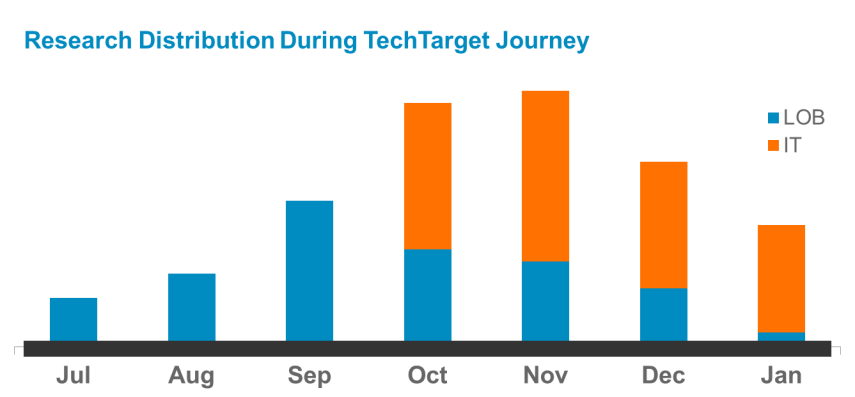- October 27, 2015
- Content, Demand Generation
I’m LOB and I Admit It, I Need IT
 Being in the business of creating content to help tech buyers buy, we spend a lot of time dissecting how those buys are actually made. One of the bigger shifts we’ve seen (as tech has made its way from supporting the business to enabling everyone from HR to Sales) is the evolution of the buying team to include a greater LOB (line-of-business) presence. We spend countless hours helping tech vendors understand this dynamic and create content and campaigns accordingly. (Want more? Click here for a deeper dive on IT & LOB buying team dynamics)
Being in the business of creating content to help tech buyers buy, we spend a lot of time dissecting how those buys are actually made. One of the bigger shifts we’ve seen (as tech has made its way from supporting the business to enabling everyone from HR to Sales) is the evolution of the buying team to include a greater LOB (line-of-business) presence. We spend countless hours helping tech vendors understand this dynamic and create content and campaigns accordingly. (Want more? Click here for a deeper dive on IT & LOB buying team dynamics)
Well, I recently got the opportunity to sit on the other side of the table and participate as the LOB champion on an enterprise buying team… and what was the first thing I tried to do you ask? Bypass IT.
Oh the irony…
4 things tech marketers can do to improve reach with entire technology buying teams
Obviously I failed, quite miserably to the say the least, so I thought it worth my time (and maybe yours) to tell myself 4 things I wish I knew heading into the journey and 4 things you can think about as a tech marketer to improve your reach with today’s buying team.
#1 – You will consider the needs of the business, not its infrastructure – and those needs will win
As LOB, I’m thinking functionality and usability or productivity and performance. I’m not thinking bandwidth and backup or retention and redundancy and guess what… if the solution I want jeopardizes those, it’s most likely out the window (barring any truly major business impediment).
As a vendor, you can (and should) help your LOB contacts understand that 1. IT has a stake in the solution too; 2. what that stake is; and, 3. how to have an informed conversation around it. If your primary contact is IT, the same rules apply.
#2 – You will use a consultant and you should trust him or her
This buy wasn’t even on the horizon for us. We had brought a consultant into the marketing organization for a series of other projects and in the process of getting started, he identified a gap, exposing me to a problem I didn’t really know I had and unique solution that I didn’t know existed.
Consultants are leads too, and really good ones. Rather than toss them out, think about how you can 1. enable them and 2. customize some content and/or nurture path to keep them engaged and your solution top-of-mind.
# 3 – You will do a lot of research, but IT will do more
Because I’m focused on features and functionalities as an LOB buyer, my information need is more singular whereas IT has to consider all the ways in which that solution can impact the infrastructure. No matter how much research I do, I’m simply looking through a different lens and need IT to do their homework too.
The chart below details the research activity through our journey. October is when the project actually got executive approval to pursue:

Create content experiences specific to the needs/tone/language of each of your buyers and influencers, but take the time to make sure the tie together- i.e. show your LOB persona what the feature/functionality is and address how IT might need to think about it. That will serve double duty when it comes to content while also enabling intra-department communication.
#4 – You will build a business case. Start early, document often
I’m learning a lot on this journey and eventually, I’m going to have to fight for budget and prioritization as well as transfer that knowledge onto my team members. It’s important to identify and detail the need, recommend an approach to solving it, provide a shortlist of options, and itemize the cost of doing nothing.
No one knows how to make the case for your product better than you, so help your prospects make it. Create a blueprint that helps those buyers understand what they’ll need to itemize and how and why your solution is best suited to deliver. You can also consider the idea of giving your LOB buyers and IT team members and idea of who should detail which pieces of information- again forcing their collaboration.
As a vendor, there’s a lot you can do with your content to help bridge the gap between the members of the buying team- particularly if you’re working with personas and/or an ABM strategy. Documenting the intersection points between these team members and thinking about how your content strategy can expose their unique information needs will not only help secure your place on the shortlist, but help expedite the deal.
If you are interested in discussing how your content strategy can impact the entire buying team, please feel free to leave a comment or connect with me on LinkedIn or Twitter.
b2b technology buyers, content strategy, IT buying research, technology marketing best practices



